#Raphael Sanzio de Urbino
Text
Art History and Names
This is my Own Damn Fault for never caring to look of course, but just found out(via This Video Essay by Snappy Dragon. plz Watch :>) that the Pre-Raphaelites were NOT, in fact, Pre-Raphael but POST Raphael, by ALLOT, like "Romantic 1850s English Victorians" Allot; they just liked medieval art and ~blamed~ Raphael for aspects of contemporary art they didn't LIKE; and Dear Readers I am FUMING!!!!
Also, upgrading this from the tags cuz it's Vital Public information, 'Raphael Sanzio de Urbino' is Raph's full name, which you can absolutely read(I think) as "God Has Healed the Saint of the City" and DAMN that name is Fly as Hell XD XD
#Romanticism#Pre Raphaelites#Victorians#Raphael#Raphael Sanzio de Urbino#Art History#Etymology#Italian#zA Writes#Our Staff#zA's Endemic Historicality#zA's Painfully Ignorant Philology
10 notes
·
View notes
Photo

#Raphael#Raffaello Sanzio da Urbino#1500s#art#painting#Isabel de Requesens#isabel#italian#1518#empress
7 notes
·
View notes
Text

Lorenzo de Medici, Duke of Urbino by Raphael Sanzio, 1520s.
88 notes
·
View notes
Text
Retratos de Agnolo y Maddalena Doni (frente); el Diluvio y Deucalion y Pyrrha (atrás) de Raffaello Sanzio (Urbino 1483 - Roma 1520) y Maestro di Serumido
Fecha: ca. 1504-1507
Técnica: Óleo sobre panel de tilo
Tamaño: 63,5 x 45 cm
Inventario: inversión 1912 núms. 61, 59
Las dos pinturas retratan a Agnolo Doni (1474-1539), un rico comerciante de telas y figura destacada entre la clase alta florentina, y su esposa, la noble Maddalena Strozzi (1489-1540), que se casó el 31 de enero de 1504. Según Giorgio Vasari (Le Vite, Edizione Giuntina 1568) las obras fueron encargadas a Rafael por Agnolo: “Mientras vivía en Florencia, Agnolo Doni, que era muy cuidadoso con su dinero en otras cosas pero dispuesto a gastarlo, aunque siempre con la mayor economía posible - en obras de pintura y escultura, en las que se deleitaba mucho, le pidió [Raphael] que hiciera retratos de él y de su esposa; estos pueden verse en posesión de Giovan Battista, su hijo, en la hermosa y muy cómoda casa de Agnolo, en Corso de'Tintori, cerca del Canto degli Alberti, en Florencia.” Agnolo también encargó la pintura redonda de la Sagrada Familia, conocida como el Tondo Doni, a Miguel Ángel Buonarroti. Ambos retratos fueron pintados en colgante y originalmente formaba un díptico, sostenido por bisagras que permitían mirar las escenas pintadas en los reversos. Se trata de dos episodios, uno consecuencia del otro, extraídos de las Metamorfosis de Ovidio: El diluvio, en el reverso del retrato de Agnolo, y el siguiente renacer de la humanidad gracias a Deucalion y Pyrrha, en el reverso del retrato de Maddalena. Estas historias, pintadas en monocromo, fueron obra de un colega del joven Raphael, cuya identidad permanece en el anonimato pero que se cree que es el llamado Maestro di Serumido, figura identificada por Federico Zeri, quien atribuyó un grupo de obras en estilo similar a este mismo artista. La elección de pintar las obras en blanco y negro refleja el gusto por los estilos flamencos que fueron populares en la Florencia de los siglos XV y XVI. donde los paneles de dípticos y trípticos tendrían tradicionalmente decoraciones monocromáticas en el reverso. Las dos escenas deben interpretarse como alegorías que parecen desear fertilidad al matrimonio. Ovidio narra cómo los dioses permitieron que Deucalion y Pyrrha, una pareja de ancianos sin hijos, se salvaran del diluvio y devolvieran la vida a la humanidad después del mismo. Por orden de Zeus, la pareja se arrojó piedras sobre los hombros, y una vez que tocaron el aceite, las piedras se convirtieron en personas: las arrojadas por Deucalion se convirtieron en hombres y las arrojadas por Pyrrha, en mujeres. Estas referencias refuerzan la teoría, defendida por la mayoría de los críticos, de que los retratos fueron encargados para el matrimonio de la joven pareja, datando entre 1504 y 1506,
Información de la web de la Gallerie degli Uffizi, imagen/es de mi autoría.
2 notes
·
View notes
Text
Trasfigurazione
Vatican City – 1976 Detail from a painting by Raffaello Sanzio of Urbino: the Transfiguration
The Transfiguration is the last painting by the Italian High Renaissance master Raphael. Cardinal Giulio de Medici – who later became Pope Clement VII – commissioned the work, conceived as an altarpiece for Narbonne Cathedral in France; Raphael worked on it in the years preceding his death in 1520.
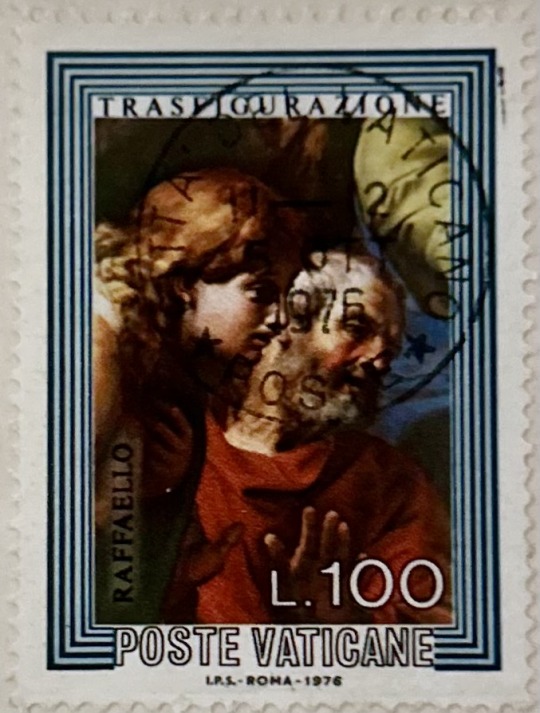
View On WordPress
0 notes
Photo

Raphael - Raffaello Sanzio - oil
The Mond Crucifixion (or Crocifissione Gavari
both names are later ex-owners) is a painting by Italian Renaissance artist Rafael. One of the first works influenced by Perugino, which was originally an altarpiece in the church of San Domenico in Città di Castello, near the birthplace of Rafael de Urbino. The painting shows Jesus on the cross, who is looking for peace, even though he is dying. There are two angels taking his blood in a cup. To the left of Jesus Mary Magdalene kneels, with John the Evangelist standing behind her. To her right, Mary (mother of Jesus) stands, and St. Jerome, to whom the altar was dedicated, is kneeling. At the foot of the cross is the inscription RAPHAEL / VRBIN / AS /. P. [INXIT] ('Raphael de Urbino painted this') in silver letters. The painting was donated to the National Gallery by Ludwig Mond.
Raphael - Raffaello Sanzio - óleo
A Crucificação Mond (ou Crocifissione Gavari
ambos os nomes são depois ex-proprietários) é uma pintura pelo artista italiano renascentista Rafael. Um dos primeiros trabalhos influenciados por Perugino, que foi originalmente um retábulo na igreja de San Domenico na Città di Castello, perto da cidade natal de Rafael de Urbino. A pintura mostra Jesus na cruz, que está à procura pacífica, embora ele está morrendo. Há dois anjos pegar o seu sangue em cálice. À esquerda de Jesus se ajoelha Maria Madalena, com João Evangelista pé atrás dela. À sua direita Maria (mãe de Jesus) stands, e São Jerônimo, a quem o altar foi dedicado, está ajoelhado. Aos pés da cruz é o RAPHAEL inscrição / VRBIN / AS /. P. [INXIT] ('Raphael de Urbino pintou esta') em letras de prata. A pintura foi doado para a Galeria Nacional por Ludwig Mond.
4 notes
·
View notes
Text
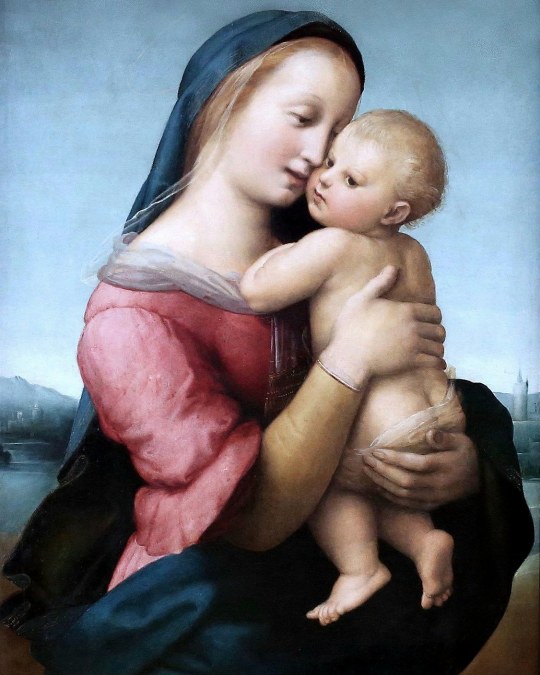
Raphael [Raffaello Sanzio/Rafael Sanzio de Urbino] (1483–1520), Tempi Madonna, 1508, oil on wood, 75 cm × 51 cm (30 in × 20 in); Alte Pinakothek, Munich, Germany.
5 notes
·
View notes
Photo
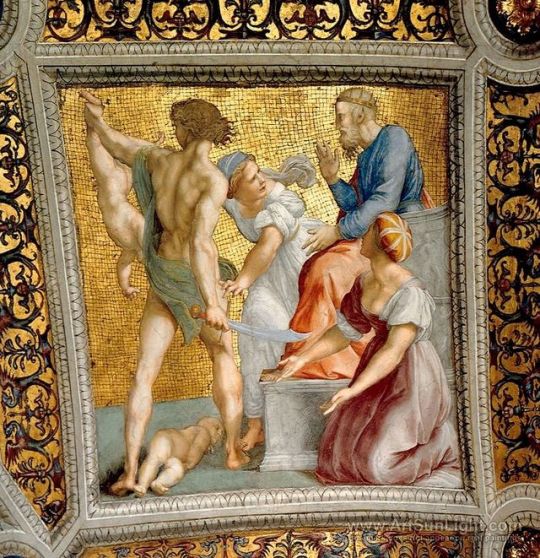
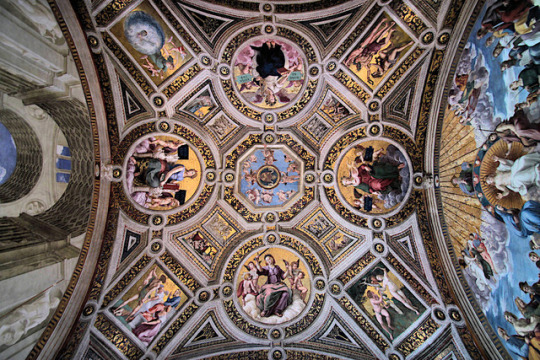
Raphael (1483 - 1520)
The Judgment Of Solomon, 1509-11, fresco 120 × 105 cm. Stanza della Segnatura ceiling detail
Raffaello Sanzio / Raffael Santi / Rafael Sanzio de Urbino
Raphael painted this fresco in the same room of the Vatican where he made the famous School of Athens: the Stanza della Segnatura. Pope Julius II had also hired Michelangelo to “decorate” Cappella Sistina, at the time.
Raphael was clearly influenced by Michelangelo's Sistine Chapel ceiling in the course of painting the room. Vasari said Bramante let him in secretly. The first section was completed in 1511 and the reaction of other artists to the daunting force of Michelangelo was the dominating question in Italian art for the following few decades. Raphael, who had already shown his gift for absorbing influences into his own personal style, rose to the challenge perhaps better than any other artist. One of the first and clearest instances was the portrait in The School of Athens of Michelangelo himself, as Heraclitus (no. 13)
#Raphael#Raphaello#Vatican#Renaissance#Raffaello Sanzio#symbol#Architecture#ceiling#fresco#large format#Michelangelo#Cappella Sistina#master#masterpiece
1 note
·
View note
Photo

6th April 1327, former Italian priest, turned poet Francesco Petrarca, more commonly known as Petrarch first sights his poetic muse Laura, at Easter mass in the church of Sainte-Claire d'Avignon. He spends the next three years writing poetry dedicated to her, and languishing from her rejection; possibly due to the fact that she was already married. The Laura in his poetry, could be Laura de Noves, whose husband, the Count Hugues de Sade, was an ancestor of the Marquis de Sade. On this same day in 1348, Laura died of the black death, sending Petrarch into an even deeper despair. Petrarch is credited with initiating the Italian Renaissance in the 14th century, through his discovery of Cicero’s letters. He is also credited with originating the concept of the ‘Dark Ages’, after the fall of Rome, which he considered ‘light’. 6th April 1483, birth of Italian painter and architect Raffaello Sanzio da Urbino, more commonly known as Raphael. On the same day in 1520 Raphael died, on his 37th birthday. The inscription in Raphael's marble sarcophagus reads: "Here lies that famous Raphael by whom Nature feared to be conquered while he lived, and when he was dying, feared herself to die." Also on the 6th April in 1528, the German painter and friend of Raphael, Albrecht Durer died. 9th April 1492, death of Florentine ruler, diplomat, statesman and patron of renaissance arts Lorenzo de' Medici, patron to Da Vinci, Botticelli and Michelangelo. Upon his death on this day, legend says that the dome of the Florence Cathedral was struck by lightning, followed by the appearance of ghosts. Liked the story? Follow @ofgrave.concern for more tales and art of the historically Gothic, strange and macabre. #historicalstories #historicalstory #petrarch #lovesick #poeticmuse #marquisdesade #blackdeath #bubonicplague #plaguedoctor #plaguedoctormask #plaguedoctorart #1348 #mortality #blackdeathdoctor #renaissance #renaissancehistory #italianhistory #raphael #italianrenaissance #14thcentury #15thcentury #albrechtdürer #onthisdayinhistory #onthisday #lorenzodemedici #florenceitaly🇮🇹 #historyofflorence #ghosthistory #diedonthisday #darkromantic https://www.instagram.com/p/CNc4PytHF-_/?igshid=18s1iad10hz1j
#historicalstories#historicalstory#petrarch#lovesick#poeticmuse#marquisdesade#blackdeath#bubonicplague#plaguedoctor#plaguedoctormask#plaguedoctorart#1348#mortality#blackdeathdoctor#renaissance#renaissancehistory#italianhistory#raphael#italianrenaissance#14thcentury#15thcentury#albrechtdürer#onthisdayinhistory#onthisday#lorenzodemedici#florenceitaly🇮🇹#historyofflorence#ghosthistory#diedonthisday#darkromantic
1 note
·
View note
Text
24 Secrets You Will Not Want To Know About Raphael Famous Paintings | raphael famous paintings
“Maske Tragen!” (Wear A Mask!”) say the posters for the Egon Schiele Friedensreich Hundertwasser … [ ] exhibition at the Leopold Building in Vienna
Museums Europe-wide are gradually reopening, with some top column lockdown art exhibitions underway or planned to to map into your biking diaries: From Raphael in Rome to Goya in Basel.
This is timely, as you’re apparently activity a bit art- as able-bodied as travel-starved afterwards months of lockdown. As Vienna’s tourism lath says: “The anxious for art is great”– boring but surely, the aboriginal museums are now aperture their doors again.
“Vienna’s museums awake,” it goes on, as the greats such as the Albertina and Kunsthistorisches Building reopen.
Of advance visiting altitude will be somewhat different, with austere assurance and hygiene rules to attach to. Article that will accord bodies a additional faculty of aegis as they attempt aback into attainable art circles again, afterwards months of basic visits.
Note the Louvre in Paris is still closed–but reopening July 6. The Musée d’Orsay opens June 23. The Centre Pompidou mid-July and the Grand Palais July 1. As French museums alpha amplification some novelties for summer and autumn programs, I’ll be accoutrement those in a approaching story.
As of June 2, the acclaimed Dutch art and history showcase, the Rijksmuseum in Amsterdam, is no best … [ ] briefly closed. And the appearance will go on – that is the “Baroque In Rome” exhibition showcasing works by two Italian greats, Caravaggio and Bernini. You can additionally arise the alive attention assignment of
24 Secrets You Will Not Want To Know About Raphael Famous Paintings | raphael famous paintings – raphael famous paintings
| Encouraged to the website, within this period I’m going to show you about keyword. And after this, this can be a primary picture:

The School Of Athens, Famous Painting By Raphael In The Vatican .. | raphael famous paintings
How about impression over? can be that wonderful???. if you think maybe therefore, I’l l explain to you some photograph yet again underneath:
So, if you desire to receive all of these magnificent shots about (24 Secrets You Will Not Want To Know About Raphael Famous Paintings | raphael famous paintings), just click save icon to store the images for your personal computer. These are all set for download, if you’d prefer and wish to grab it, click save badge on the page, and it’ll be instantly down loaded in your notebook computer.} At last if you would like receive new and latest graphic related with (24 Secrets You Will Not Want To Know About Raphael Famous Paintings | raphael famous paintings), please follow us on google plus or save this site, we try our best to offer you daily up-date with fresh and new shots. Hope you love staying right here. For some upgrades and latest information about (24 Secrets You Will Not Want To Know About Raphael Famous Paintings | raphael famous paintings) pictures, please kindly follow us on twitter, path, Instagram and google plus, or you mark this page on bookmark area, We try to give you up grade periodically with all new and fresh graphics, love your browsing, and find the ideal for you.
Here you are at our site, contentabove (24 Secrets You Will Not Want To Know About Raphael Famous Paintings | raphael famous paintings) published . At this time we are excited to announce we have found an extremelyinteresting contentto be pointed out, namely (24 Secrets You Will Not Want To Know About Raphael Famous Paintings | raphael famous paintings) Most people trying to find information about(24 Secrets You Will Not Want To Know About Raphael Famous Paintings | raphael famous paintings) and definitely one of these is you, is not it?
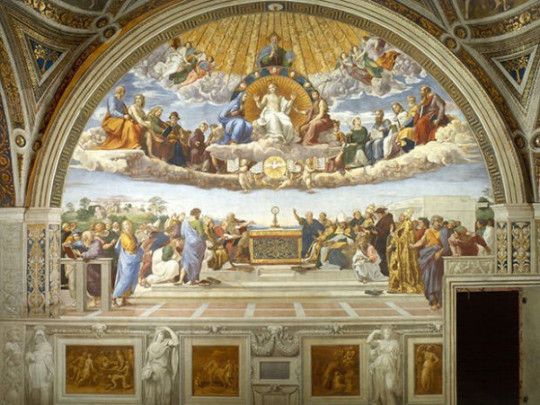
Raphael Santi (March 24, 24 — April 24, 24), Italian architect .. | raphael famous paintings
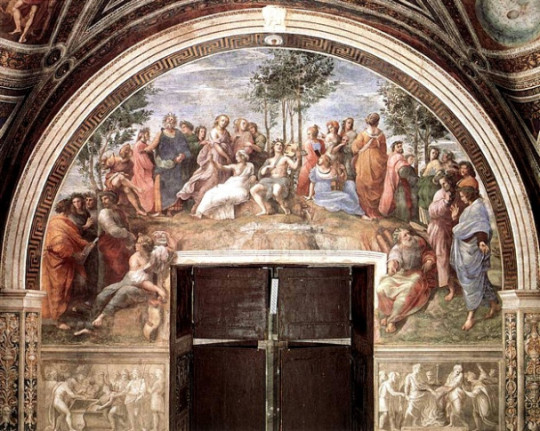
Habitaciones disponibles Vaticane – el parnaso de Raphael .. | raphael famous paintings
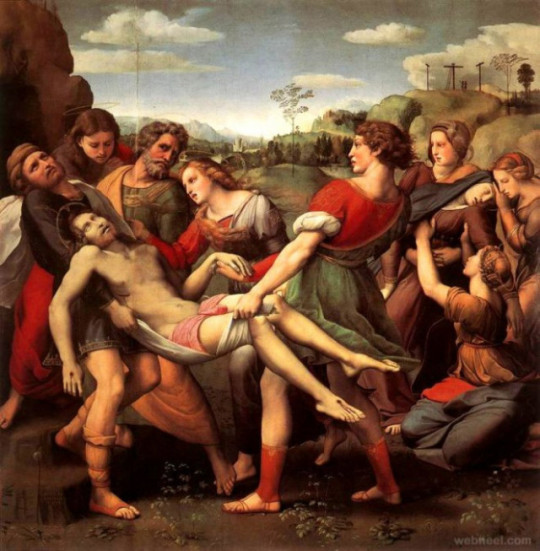
24 Beautiful Raphael Paintings – Most Famous Italian Painter – raphael famous paintings | raphael famous paintings

24 of the Most Famous Paintings and Artworks by Raphael .. | raphael famous paintings

24 famous artists who hid self-portraits in their paintings – CNN Style – raphael famous paintings | raphael famous paintings

la expulsión de heliodoro de Raphael (Raffaello Sanzio Da Urbino .. | raphael famous paintings
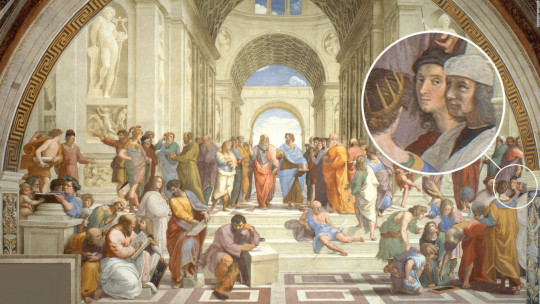
24 famous artists who hid self-portraits in their paintings – CNN Style – raphael famous paintings | raphael famous paintings
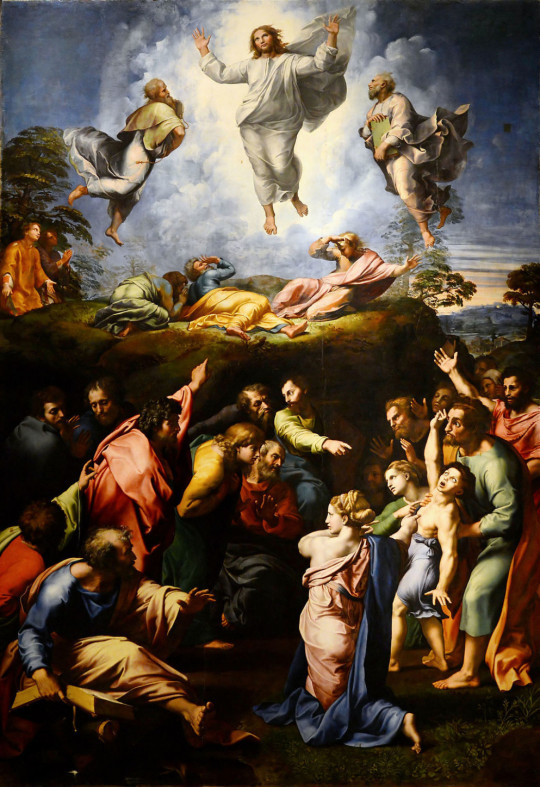
24 of Raphael’s Greatest Paintings – Artsy – raphael famous paintings | raphael famous paintings
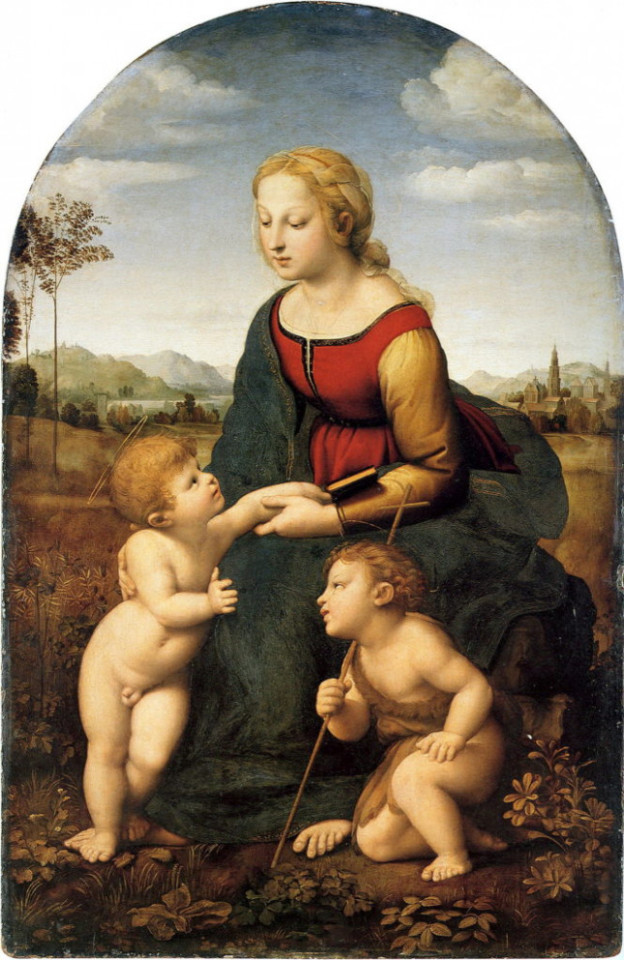
The 24 Best Artworks by Raphael, Seraphic Genius of the .. | raphael famous paintings
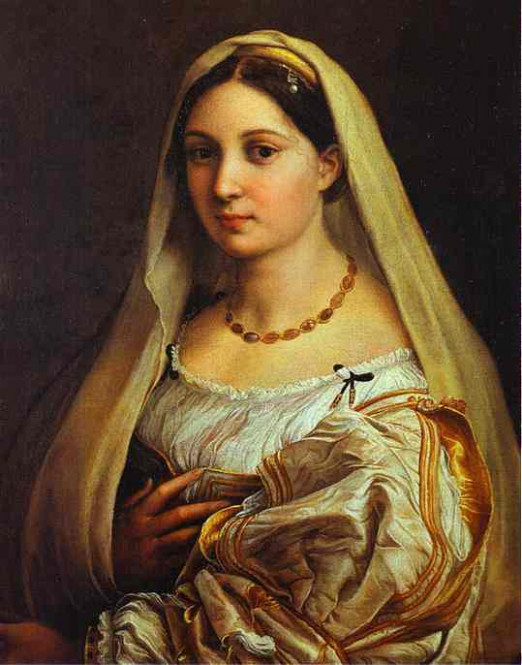
la donna velata de Raphael (Raffaello Sanzio Da Urbino .. | raphael famous paintings

US $24 | raphael famous paintings
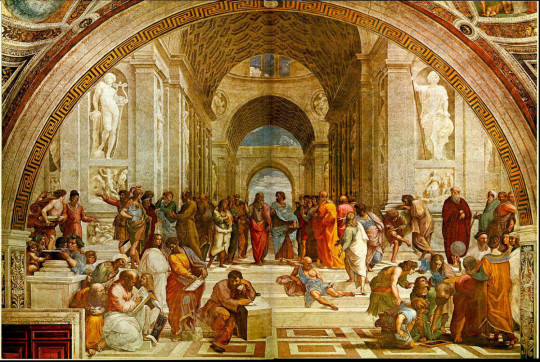
24 of the Most Famous Paintings and Artworks by Raphael .. | raphael famous paintings

Raphael – Wikipedia – raphael famous paintings | raphael famous paintings
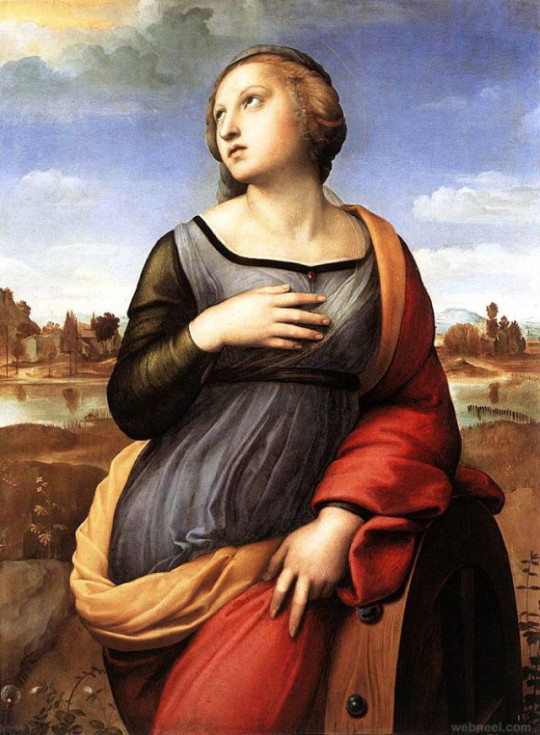
24 Beautiful Raphael Paintings – Most Famous Italian Painter (With .. | raphael famous paintings

retrato de un dama con un `unicorn de Raphael (Raffaello Sanzio Da .. | raphael famous paintings
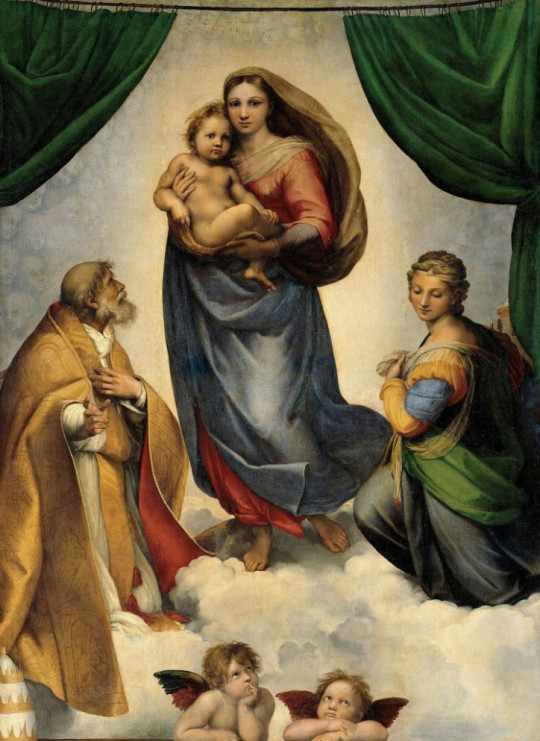
The 24 Best Artworks by Raphael, Seraphic Genius of the .. | raphael famous paintings
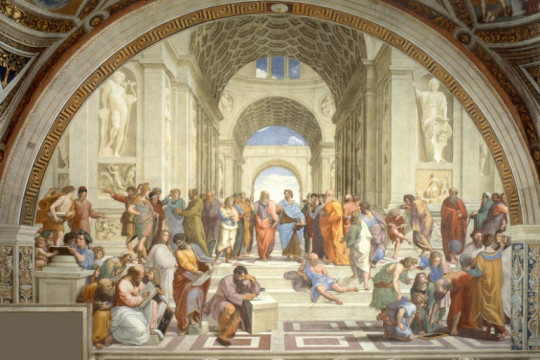
The School of Athens by Raphael, 24 – Italian Renaissance Fresco Painting – Famous Art – High Renaissance – Philosophy Student Gift – raphael famous paintings | raphael famous paintings

24 Beautiful Raphael Paintings – Most Famous Italian Painter (con .. | raphael famous paintings

Raphael Artworks & Famous Paintings | TheArtStory – raphael famous paintings | raphael famous paintings

24 of Raphael’s Greatest Paintings – Artsy – raphael famous paintings | raphael famous paintings
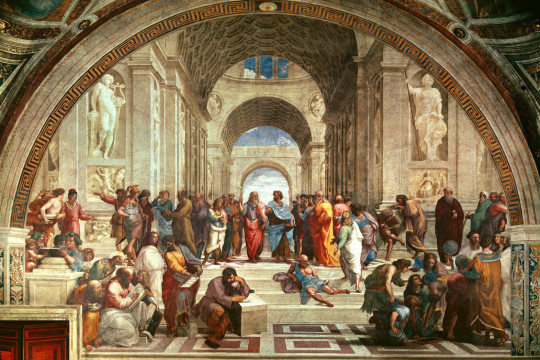
School of Athens by Raphael – Famous Art – Handmade Oil Painting .. | raphael famous paintings
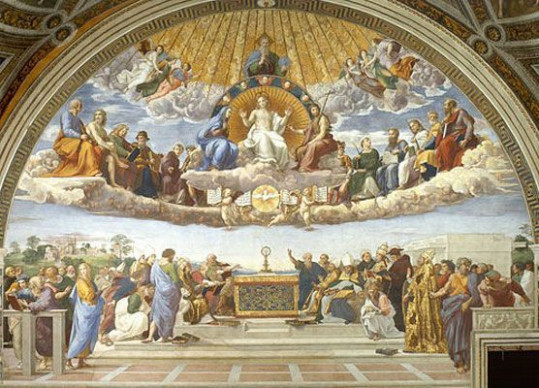
Raphael Artworks & Famous Paintings | TheArtStory – raphael famous paintings | raphael famous paintings

24 Most Famous Paintings by Raphael | Learnodo Newtonic – raphael famous paintings | raphael famous paintings
The post 24 Secrets You Will Not Want To Know About Raphael Famous Paintings | raphael famous paintings appeared first on Painter Legend.
Painter Legend https://www.painterlegend.com/wp-content/uploads/2020/06/the-school-of-athens-famous-painting-by-raphael-in-the-vatican-raphael-famous-paintings.jpg
0 notes
Photo
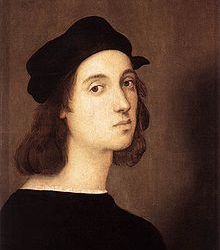
Sanzio Raffaello (Santi Raphael) Kimdir? RAFFAELLO Sanzio (Santi), İtalyan ressamı ve mimarı (Urbino 1483-Roma 1520). 1498’de Petro Perugino’ nun atölyesinde resim eğitimi gördü.
0 notes
Photo
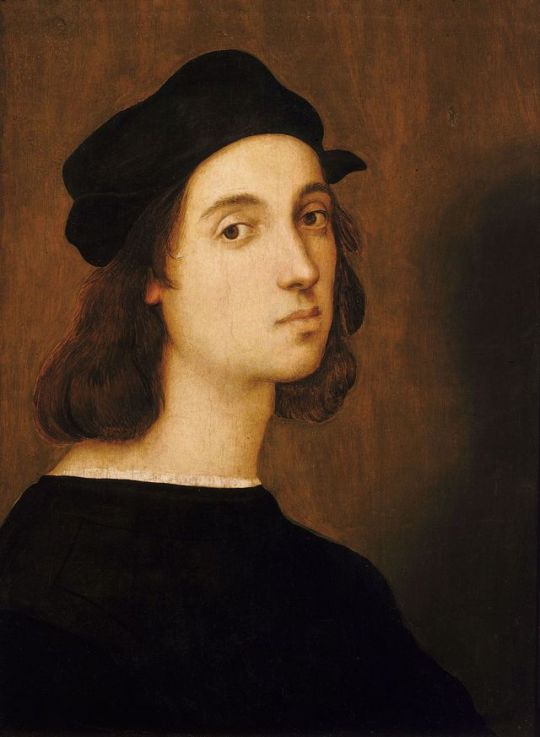
[Artist of the week] – Raphael
Raffaello Sanzio da Urbino (1483 - 1520), better known simply as Raphael, was an Italian painter and architect of the High Renaissance. His work is admired for its clarity of form and ease of composition and for its visual achievement of the Neoplatonic ideal of human grandeur. Together with Michelangelo and Leonardo da Vinci, he forms the traditional trinity of great masters of that period.
Raphael is considered one of the most important and brilliant artists of the Italian Renaissance. He painted and designed many astonishing pieces of work inside the Vatican and was a master at using depth and perspective, along light and shadow - the cornerstones of modern day art. Throughout his short life, Raphael would make some of the most awe-inspiring, beautiful and influential works of the Italian Renaissance.
By 1501, Raphael was held in high esteem and he gained important commissions, such as the Mond de Crucifixion in 1503. The following year Raphael lived mainly in Florence, which was a burgeoning centre of the renaissance. He became acquainted with Leonardo da Vinci and Michelangelo (whom he fell out with on numerous occasions)
In 1508, he was charged with decorating the Vatican library (now named the Stanza della Segnatura). This was at the same time as Michelangelo was painting the Sistine Chapel, and although the Sistine chapel overshadowed the work of Raphael, his paintings are still considered some of the finest of European art. This work included some of masterpieces such as – The School of Athens, The Parnassus and the Disputa. The High Renaissance tribute to the ancient Greek culture.
Vasari says that Raphael eventually had a workshop of fifty pupils and assistants, many of whom later became significant artists in their own right. This was arguably the largest workshop team assembled under any single old master painter, and much higher than the norm.
The Art Appreciation Course consists of 12 modules and 12 assignments. The second module, The Renaissance has been authored by Andrew Graham-Dixon. To find out more about the course visit our website: www.the-art-institute.com/landing
Presumed Portrait of Raphael
1 note
·
View note
Text
Los Angeles County Museum of Art (LACMA)
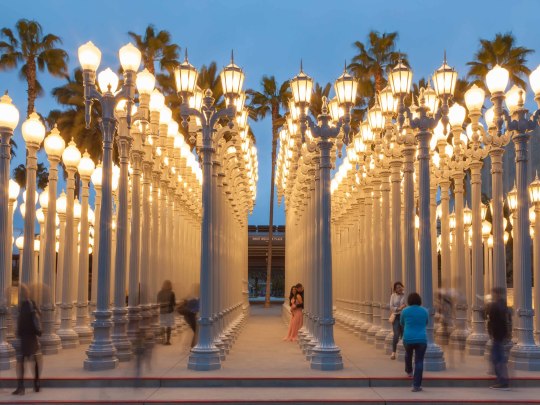
The Los Angeles County Museum of Art (LACMA) has been dedicated to collecting works of art that span history and geography and representing Los Angeles' exceptionally varied population since its founding in 1965. Today, LACMA is one of the most excellent art museums in the western United States, with a collection of over 150,000 artifacts spanning the globe and practically the entire history of art, stretching from antiquity to the present and attracts nearly a million visitors each year. LACMA was founded in 1961 and opened in 1965, located between the coast and downtown in Hancock Park, which spans over 20 acres in the heart of Los Angeles and has been an integral part of LA for decades, providing a space for exhibitions, performances, films, and even classes to the public.
In recent decades, LA has become the art hub of California, with several eye-catching galleries and museums. Yet LACMA is still one that stands above all others - its vast collection spanning millennia means it has something for everyone; from the latest contemporary artists to ancient pottery, everything here will give you goosebumps. It's also been recognized as one of the best art museums in America - just ask Trip Advisor!
The Ahmanson Building, the Bing Center, and the Lytton Gallery were the three buildings that made up the Museum, which was designed in Lincoln Center and the Los Angeles Music Center. The main building was designed by architect William Pereira. For more than 50 years now, people from all over have been coming to this cultural institution for its diverse exhibitions that showcase their works by artists like Salvador Dali or Gustav Klimt. With so much variety, you're bound to find something you love!
LACMA's collections span more than two thousand years. It also houses famous paintings such as Vincent Van Gogh's Irises or Georges Seurat's A Sunday on La Grande Jatte. Asian art, Latin American art, ranging from pre-Columbian classics to works by famous modern and contemporary artists, and Islamic art, of which LACMA houses one of the world's most important collections, are among the Museum's strengths.
LACMA has long been known for its broad collections spanning across many periods and genres, as well as modern works by artists such as Jasper Johns. Still, it also owns pieces from antiquity through contemporary times—including traditional African masks from Gabon (19th-cent drawings by Michelangelo Buonarroti, Leonardo da Vinci, Raphael Sanzio de Urbino, and Rembrandt van Rury). LACMA was one of the first museums to join Google's Art Project. The Museum features a collection of artworks and artifacts showcased in an online virtual tour with high-resolution images.
The Museum is now preparing to develop the David Geffen Galleries. This new permanent collection building is set to open in 2024. The pieces will be on exhibit in the BCAM and the Resnick Pavilion for the time being. The exhibition Urban Light and Levitated Mass are still open to the public. Many visitors praise the artwork on display, but some regret that most of it are currently off-limits due to construction.
Tour, Exhibitions, Event & Educational Programs
The Museum presents exhibitions that are drawn from its permanent collection, the work of living artists, or recent acquisitions. It also mounts special exhibits and features a series of rotating presentations in its galleries, such as lectures, film screenings, and workshops. Educational program and outreach activities are offered in conjunction with exhibitions, including lectures and tours led by Museum educators and curators who provide insights into the works on view.
The Los Angeles County Museum of Art is a great place to enjoy the arts. It has a lot to offer, and there are plenty of activities for people of all interests. What can you do in LACMA? There's so much! Like their current exhibition on Bali art, walking through some beautiful exhibits is one thing that everyone should try at least once. You'll find pieces from many different artists - both well-known names as well as emerging talents - who have lived or exhibited work in this region over decades, represented by paintings, photographs, sculptures, and installations. The Museum also hosts concerts and performances throughout the year, which allow audiences an up-close experience with diverse musical styles such as traditional Balinese gamelan or tango.
In addition to their galleries, LACMA has an auditorium that can seat 600 people and a theater with productions from around the world. It's easy to spend all day here but make sure to have lunch in one of the cafés first! There are three restaurants on the premises. While travelers praise the food, they point out that the eateries are a little on the pricey side. But it's worth it!
Check out their tours that are designed specifically for you!
The Museum has guided walking tours throughout the day on Mondays through Saturdays.
You'll get an overview of all major galleries as well as have access to one gallery exclusively reserved just for kids.
A curator will be on hand to talk about the art and answer any questions that you might have.
It's no secret - the LA County Museum of Art is one of California's most iconic institutions, a beacon for art lovers from all over. But it can be difficult to visit if you have mobility issues or are blind and need braille guides in order to navigate the galleries. Fortunately, this isn't much of a problem as they provide tours with special needs! The LACMA is wheelchair accessible and offers interpreters, hearing loop systems, and assistive listening devices for visitors with visual or auditory impairments.
LACMA also offers many opportunities for corporations to come and explore the Museum. They have a variety of sponsorship opportunities available, including corporate partnerships and memberships with LACMA or through your company's foundation. To learn more about how you can get involved, please email them at [email protected].
The Museum is open every day except Wednesdays, Thanksgiving Day, and Christmas Day. To learn more about the Los Angeles County Museum of Art, visit their website at https://www.lacma.org.
youtube
1 note
·
View note
Text
Rafael: a perfeição no Renascimento Pleno
Classificado entre os grandes e insuperáveis mestres do Renascimento Pleno, pintor de qualidades insuperáveis, Rafael de Sanzio[1] (1483-1520) viveu em busca da perfeição, da harmonia e do equilíbrio, inspirando-se nos conceitos clássicos.
Provavelmente, Rafael estudou pintura com seu pai, Giovanni Santi, pintor da corte de Urbino, sua terra natal. Jovem, frequentou o estúdio de PERUGINO[2] (ca.1448-1523), dominando o estilo delicado e ornamental do mestre.
No final de 1504, Rafael chegou em Florença, no período em que DA VINCI (1452-1519) e MICHELANGELO (1475-1564) estavam desenvolvendo novos modelos artísticos, entre eles: os grupos de figuras incrivelmente naturais e o uso do sfumato.
Tranquilo, o artista dedicou-se a aprender com as obras dos mestres, angariando recomendações dos grandes mecenas e muito trabalho.
Com uma personalidade agradável, figuras de rara beleza representadas em um espaço harmonioso, delicado, emotivo e, principalmente, religioso, Rafael soube como ninguém se relacionar e agradar os representantes da igreja.
São inúmeras as obras produzidas durante a estadia de Rafael em Florença, entre elas a Virgem do prado[3], executada por volta de 1505 e 1506, em que mostra o encontro do Menino Jesus com João Batista, obra na qual é visível a influência de Michelangelo e o desejo de se chegar ao sfumato de Da Vinci.
Quatro anos depois de intensa atividade em Florença, Rafael foi em busca de novos horizontes na cidade de Roma, sede do mundo cristão.
RAFAEL de Sanzio (1483-1520) Madona e o Menino Entronados com Santos, ca. 1504. Óleo e ouro sobre madeira. 169.5×168.9. Luneta, 171,5×64,8. The Metropolitan Museum of Art, Nova York, EUA.
Rafael, ainda muito jovem, pintou este retábulo para o convento franciscano de Sant’ Antonio em Perúgia. A Luneta mostra Deus pai, abençoando a cena inferior, cercado por dois anjos. A composição, extremamente tradicional, da Madona entronada sob o baldaquino e dossel de madeira, das santas[4] protetoras e das crianças vestidas, indicam o pedido conservador por parte das freiras do convento religioso. No entanto, a representação de São Paulo e São Pedro, no primeiro plano, anunciam as primeiras lições com os mestres do Renascimento Pleno, na chegada à Florença. Madona e o Menino Entronados com Santos combina o aprendizado perugiano com a nova estética descoberta em Florença.
Sentado no colo de Maria, o menino Jesus abençoa São João Batista. Do lado esquerdo, São Pedro, olhando para fora, segura o livro Sagrado e as chaves do céu. Do lado direito, São Paulo, compenetrado, tem nas mãos o Novo Testamento e a espada, usada em seu martírio.
Atrás de São Pedro, Santa Catarina segura um ramo de palma e se apoia com a mão direita sobre uma roda com lâminas, com a qual se tentou seu martírio. A outra santa, que pode ser Santa Cecília ou Santa Margarete, segura o livro sagrado e o ramo de palma significa que ela também foi martirizada em nome da fé.
O Retábulo vendido no século XVII, foi doado ao Metropolitan no século XX.
RAFAEL de Sanzio (1483-1520) A Sagrada família da casa de Canigiani, 1505/1506. Pintura sobre madeira. 131×107.Bayerische Staatsgemäldesammlungen. Alte Pinakothek, Munique, Alemanha.
A pintura é do tempo em que Rafael viveu em Florença. A composição piramidal, mostra a Sagrada Família, nas figuras de São José e Maria com o menino Jesus, acompanhados pela prima, Santa Isabel e por São João Batista, enquanto do alto putti[5] se divertem entre nuvens no céu. Maria carinhosamente observa os pequenos, enquanto Isabel parece conversar com São José.
No horizonte, ao fundo, entre colinas e montanhas, despontam os pináculos das torres e construções típicas de uma cidade italiana.
RAFAEL de Sanzio (1483-1520) Madona de Alba, ca. 1510. Óleo sobre painel transferido para tela, 94,5 de diâmetro. National Gallery of Art, Washington, EUA.
Executada na cidade romana, Madona de Alba ou Madona da Humildade, é apresentada por Rafael assentada diretamente sobre o solo em vez do trono celestial ou sobre uma almofada suntuosa. Um velho tronco é o seu apoio. Ao fundo a tranquila paisagem recorta o horizonte na terceira parte da composição, enquanto o manto de Maria pousado na terra marca o equilíbrio horizontal e o primeiro plano.
O grupo piramidal encontra-se no interior do tondo[6], um formato popular no período.
Maria dá uma pausa na leitura e marca a página do livro de orações[7]. A mão direita apoia João Batista, no momento em que ele entrega a cruz para Jesus.
“A atmosfera serena e bucólica desmente o significado emocional: o menino Jesus aceita a cruz de João Batista, observado pela mãe – no momento em que sente a antecipação do sacrifício de Cristo pela humanidade”. (NATIONAL GALLERY OF ART,Washington, EUA. Tradução nossa[8])
Referências
BAYERISCHE STAATSGEMÄLDESAMMLUNGEN. ALTE PINAKOTHEK, Munique, Alemanha.. Inventory Number: 476. PUBLIC DOMAIN. Bayerische Staatsgemäldesammlungen – Alte Pinakothek München. Disponível em https://www.sammlung.pinakothek.de/en/bookmark/artwork/M0xy2k5Lpl Acesso em 12 ago. 2019.
GOMBRICH, E. H. A História da Arte. Tradução Álvaro Cabral. Rio de Janeiro: LTC, 2000. 714 p.
MARTINI, Fátima R. S. A Pintura Renascentista e Maneirista nos Museus. In Curso de Extensão/UNIMES virtual. Santos/SP: UNIMES, 2016. 57 p.
NATIONAL GALLERY OF ART,Washington, EUA. Disponível em: https://www.nga.gov/collection/art-object-page.26.html Acesso em: 10 ago. 2019.
NATIONAL GALLERY OF ART,Washington, EUA. Disponível em: https://www.nga.gov/collection/art-object-page.1196.html Acesso em: 16 ago. 2019.
THE METROPOLITAN MUSEUM OF ART, Nova York, EUA. Disponível em: https://www.metmuseum.org/art/collection/search/437372 Acesso em: 13 ago. 2019.
[1] Filho do pintor e poeta, Giovanni Santi (ca. 1435-1494), Rafael também é conhecido por Rafael Sanzio, Rafaello Sanzio, Raphael Sanzio e Rafael Santi,
[2] Pietro Vannucci, conhecido por PERUGINO (ca.1448-1523) montou duas das mais influentes oficinas artísticas: uma em Florença e outra em Perúgia. Influenciado pela pintura monumental dos artistas da Úmbria, Perugino mesclou em sua obra os ensinamentos dos primeiros renascentistas: Piero DELLA FRANCESCA (1416/17-1492), MASACCIO (1401-1428/9), Fra Filippo LIPPI (ca. 1406-1469) e Andrea del VERROCCHIO (1435-1488)
[3] RAFAEL de Sanzio (1483-1520) Virgem do Prado, ca. 1505/1506. Óleo sobre madeira, 113×88. Kunsthistorisches Museum, Viena, Áustria
[4] Santa Catarina e, provavelmente, na falta de consenso: Santa Cecília ou Santa Margarete.
[5] Quando a pintura foi restaurada em 1982/3 surgiram os anjinhos (putti, para os italianos) que estavam cobertos por tinta azul, de uma provável restauração anterior, no século XVIII. O menino alado (putto no singular) à direita, parece inacabado ou é possível que tenha sofrido danos nas restaurações.
[6] Composição realizada no interior de uma forma circular, chamada de tondo ou de tondi, quando no plural. A forma foi usada por muitos artistas do Renascimento. Uma das mais conhecidas e considerada uma das obras primas do Cinquecento italiano, é o Tondo Doni, executada por MICHELANGELO (1475-1564) em cerca de 1506-1508, encomendada por Agnolo Doni, presente no acervo da Galleria degli Uffizi, Florença, Itália.
[7] Um gesto semelhante apresentado nessa mesma página, na obra anterior: A Sagrada família da casa de Canigiani, 1505/1506. Alte Pinakothek, Munique, Alemanha. Uma prova que os melhores artistas copiam seus mestres e a si mesmos, em uma incessante busca de superação.
[8] The serene, bucolic atmosphere of Raphael’s tondo belies its emotional meaning. The Christ Child’s gesture of accepting the cross from the Baptist is the focus of attention of all three figures, as if they have foreknowledge of Christ’s sacrifice for mankind. NATIONAL GALLERY OF ART,Washington, EUA. Disponível em: https://www.nga.gov/collection/art-object-page.26.html Acesso em: 10 ago. 2019.
Veja também sobre o Renascimento
https://ift.tt/32HgMfe
O post Rafael: a perfeição no Renascimento Pleno apareceu primeiro em arteref.
Rafael: a perfeição no Renascimento Pleno Publicado primeiro em https://arteref.com
0 notes
Text
Bộ ba bậc thầy vĩ đại của thời kỳ Phục Hưng, họ là ai?
Thời kỳ Phục Hưng là cuộc tái sinh các giá trị nghệ thuật, tư tưởng, khoa học của thời kì Hy Lạp cổ đại, đại biểu ưu tú của nền văn minh phương Tây. Đây được đánh giá là giai đoạn hưng thịnh nhất của mỹ thuật thế giới. Những tìm tòi mới lạ đã đem đến một luồng khí mới, trào lưu mới cho các hoạ sĩ. Trong giai đoạn này, nổi lên bộ ba bậc thầy vĩ đại về hội họa, kiến trúc, đó là Raphael, Michelangelo, Leonardo da Vinci
Raphael
[caption id="" align="aligncenter" width="467"] Chân dung bán thân của Raphael (Ảnh: Wikipedia)[/caption]
Raphael, tên đầy đủ là Raffaello Sanzio da Urbino (1483 – 1520) là họa sĩ và kiến trúc sư nổi tiếng người Ý. Năm 1504, khi chỉ mới 21 tuổi, Raphael đã sáng tác nên tác phẩm nổi tiếng “Hôn lễ của Đức mẹ đồng trinh” dành cho nhà thờ San Francesco, Città di Castello.
[caption id="" align="aligncenter" width="700"] Bức “Hôn lễ của Đức mẹ đồng trinh”, năm 1504 (Ảnh: Wikipedia)[/caption]
Raphael còn nổi tiếng là đại diện xuất sắc với chủ đề “Thánh Mẫu tử”, một chủ đề rất hấp dẫn và đã tồn tại trong một thời gian dài. Bên cạnh số lượng lớn tác phẩm nghệ thuật có nguồn gốc từ nhà thờ để ca ngợi Chúa và làm nổi bật sự trường tồn và vĩ đại của Ngài, ông còn đặc biệt yêu thích sự thánh thiện, tình yêu và sự ngây thơ của chủ đề “Thánh Mẫu tử”. Vì vậy bản thân Raphael đã vẽ nhiều bức “Thánh Mẫu tử” trong cuộc đời mình.
[caption id="" align="aligncenter" width="702"] Bức “”Madonna Sistine”, Bảo tàng Alte Meister, Dresden, Đức (Ảnh: Epoch Times)[/caption]
Trong số đó, nổi tiếng nhất có thể kể đến những tác phẩm như “The Madonna del Granduca” (năm 1505), “La Belle Jardiniere” (năm 1507), “Tempi Madonna” (năm 1507), đặc biệt phải kể đến tác phẩm “Madonna Sistine” (năm 1514). Những bức tranh về "Thánh Mẫu Tử" của ông đã đạt tới sự hoàn mỹ về vẻ đẹp của Đức Mẹ, trở thành “khuôn vàng thước ngọc” hình ảnh Đức Mẹ kể từ đó cho đến tận thế kỷ 21 này vẫn không thay đổi.
Michelangel
[caption id="" align="aligncenter" width="407"] Chân dung Michelangelo (Nguồn ảnh: epochtimes)[/caption]
Vào ngày 6 tháng 3 năm 1475, Michelangelo được sinh ra ở Caprese, gần Arezzo, miền trung nước Ý. Thở bé, Michelangelo được gửi đến Settignano, một ngôi làng gần Florence. Ngôi làng này nổi tiếng với công nghề tạc đá. Michelangelo được ở cùng những người thợ đá. Đây là tiền đề cho sự ra đời của một nhà điêu khắc tài năng.
Mười bốn tuổi, Michelangelo được cha gửi đến nhà người họa sĩ nổi tiếng Domenico Ghirlandaio bên ngoài thành phố Florence để học tập. Trong thời gian học việc, Michelangelo thường sao chép các tác phẩm của các họa sĩ đi trước.
Năm 1492, Michelangelo trở về nhà của cha ông. Trong thời gian này, với sự hỗ trợ của tu viện trưởng Santo Spirito của nhà thờ Florence, ông có thể sử dụng những thi thể trong bệnh viện của tu viện để nghiên cứu giải phẫu, khám phá bí ẩn về cấu trúc cơ thể con người. Đây là tiền đề quan trọng cho những thành công của ông sau này.
[caption id="" align="aligncenter" width="700"] Tác phẩm “Pietà” - Tượng Đức Mẹ Sầu Bi (Ảnh: artium)[/caption]
Tháng 11 năm 1497, viên đại sứ Pháp tại Tòa thánh – Jean Bilhères de Lagafas – đã ủy nhiệm cho Michelangelo thực hiện tác phẩm điêu khắc “Đức Mẹ sầu bi”. Công việc này được Michelangelo thực hiện tại nghĩa trang của Nhà nguyện Santa Petronilla và được hoàn thành hai năm sau đó, khi Michelangelo chỉ mới 24 tuổi. Tuyệt tác này đã tạo cho ông danh tiếng là một nhà điêu khắc vĩ đại.
Một tác phẩm khác không thể không nhắc tới của Michelangelo, đó là bức tượng "David", đại biểu cho linh hồn của Florence.
[caption id="attachment_1132487" align="aligncenter" width="650"] Tượng "David" tại học viện mỹ thuật florence (Ảnh: epochtimes)[/caption]
Leonardo da Vinci
Leonardo da Vinci tên đầy đủ là Leonardo di ser Piero da Vinci (1452-1519), ở thị trấn Vinci vùng Tuscan, cộng hòa Florence. Ông được coi là một thiên tài toàn năng người Ý.
[caption id="" align="aligncenter" width="700"] Leonardo Da Vinci và kiệt tác ‘Mona Lisa’ của ông (Ảnh: dkn.tv)[/caption]
Leonardo lớn lên trong gia đình của cha ông và sống phần lớn thời gian thời thiếu niên tại thành phố Firenze. Trong số những đam mê của ông, Leonardo yêu thích nhất là âm nhạc, vẽ và tạo hình. Ser Piero đã chọn Andrea del Verrocchio làm thầy của Leonardo khi Verrochio nhận ra tài năng về nghệ thuật của Leonardo.
Trong khoảng thời gian từ 1495 đến 1497 Leonardo vẽ một trong những bức tranh nổi tiếng nhất của ông, bức bích họa Bữa ăn tối cuối cùng trong nhà thờ Santa Maria delle Grazie, theo yêu cầu của Ludovico Sforza. Đây là tác phẩm hoàn hảo nhất của Da Vinci, được đặt trong phòng ăn của Tu viện Santa Maria ở Milan. Với ý tưởng tuyệt diệu, ngôn ngữ cơ thể của nhân vật rất sinh động, tựa như một vở hí kịch trong đó mỗi người có một trạng thái nội tâm khác biệt. Năm 1980 nhà thờ cùng với bức tranh đã được UNESCO công nhận là di sản văn hóa thế giới.
[caption id="" align="aligncenter" width="700"] Bức tranh tường “Bữa tối cuối cùng”, 1498, Tu viện Santa Maria, Milan (Nguồn ảnh: epochtimes)[/caption]
Da Vinci bắt đầu vẽ Mona Lisa vào khoảng năm 1503, bức tranh nổi tiếng thứ hai của ông. Tuy nhiên trong nhiều thế kỷ, nụ cười của “Mona Lisa” được cho là “độc nhất”, “tà khí” và “mê hoặc”. Mãi tới giữa thế kỷ 19 tác phẩm mới bắt đầu nổi tiếng khi các nghệ sĩ của phong trào Biểu tượng bắt đầu ca ngợi nó, và gắn nó với những ý tưởng của họ về sự bí ẩn của phụ nữ.
from Đại Kỷ Nguyên - Feed - https://ift.tt/2PcJFe6
via IFTTT
0 notes
Text
Hidden Art on Banknotes
The wads of banknotes that you carry around and so often spend are miniature versions of art treasures! Have you ever noticed what beauties they depict? Though the banknote designs in themselves are a work of art, they also sport some famous masterpiece paintings on them. Painting is an art which enables us to find and lose ourselves in it at the same time! It is such a beautiful depiction of complex human emotions, the nature and the unthinkable abstract. Going to the art galleries in the faraway lands cannot be feasible for all…but you can behold some of these beauties in your currency notes! Let’s embark on a journey that will reveal the unseen and the hidden art on banknotes…
a) 100 French Francs (1997): This deep brown, orange and green note has the famous French painter Paul Cezanne on its obverse. Paul Cezanne was a preeminent painter of Post-Impressionist era. Known as the “Master of Aix”, Cezanne is credited with introducing the emergence of twentieth-century modernism or abstract art.
One of his famous painting “Apples and Biscuits” is depicted on the reverse. This painting is one of Cezanne’s most stunning masterpieces and symbolizes his great mastery of still life painting. This painting of 1880 hangs today in Musée de l’Orangerie in Paris, France.
b) 100 French Francs (1978): This 100 Francs note of 1978 shown in the image has another famous French painter Eugene Delacroix and his famous paintings. The obverse sports this French Romantic painter’s self-portrait along with his very famous painting of “Liberty leading people”. This painting commemorates the July Revolution of 1830, which toppled King Charles X of France.
The reverse has the same self-portrait of Delacroix holding a quill pen and writing his famous diary set against the background of “Place de Furstenberg” a famous and one of the most charming squares in Paris, where Delacroix worked and lived at 6 Rue de Furstenberg while he was commissioned to paint murals for nearby St. Sulpice.
a) 5 Marks Germany: A 5 mark note issued in Germany from 1960 to 1990 depicts a beautiful “Portrait of a Young Venetian Woman” painted in 1505 by Albrecht Durer on its obverse. Albrecht Durer was a painter, printmaker and theorist of the German Renaissance. He established his reputation and influence across Europe due to his high-quality woodcut prints. His watercolour paintings also mark him as one of the first European landscape artists.
“Portrait of a Young Venetian Woman” which decorates this 5 mark currency note hangs in Kunsthistorisches Museum Vienna today. This painting is a small bust-length oil on elm panel painting, executed along with a number of other high-society portraits by the artist in 1505. Painted in the autumn or in the winter, this painting emanates an extraordinary charm in the hues of brown and gold. The reverse of the note depicts an oak sprig in the centre.
b) 100,000 Lires Italy: Michelangelo Merisi de Caravaggio, a famous Italian painter’s paintings adorn the 100000 lire banknote of Italy of 1983 and 1994 series. Caravaggio’s technique was as spontaneous and he painted right into the canvas with minimal preparation. He made his paintings appear to be an extension of real space, deliberately making the viewers to feel as if they are taking part in the scene. Sounds like 3D, doesn’t it? His paintings combined the realistic observation of the human state, both physical and emotional with the dramatic use of lighting.
This note sports the portrait of Caravaggio on the obverse along with his famous painting of the “Fortune Teller”. The reverse has his “Fruit basket” with a castle in the background.
a) 500,000 lire (Italy): A vibrant and colourful banknote from Italy in circulation in 1997 has one of the famous fresco “The Triumph of Galatea” depicted on the obverse along with the artist Raphael. Raffaello Sanzio da Urbino was an Italian painter and architect of the High Renaissance. He is one of the traditional trinity of great masters along with Michelangelo and Leonardo Da Vinci. Many of his works are found in the Vatican Palace.
His best-known work “The School of Athens” which is in the Vatican Stanza Della Segnatura is depicted on the reverse of this note. It was painted between 1509 and 1511 in Apostolic Palace in the Vatican. The School of Athens is one of a group of four main frescoes that depict distinct branches of knowledge. The fresco has all the major philosophers and thinkers from Plato, Aristotle, and Socrates to Pythagoras and Ptolemy. Considered to be one of the masterpieces of Vatican this fresco has decorated this banknote too and indeed increased its beauty.
b) 20,000 Lire (Italy): A 1975 20000 Lire banknote from Italy features yet another master along with his famous masterpieces! The obverse of this green, brown and red note depicts Tiziano Vecelli or Tiziano Vecellio (Titan in English), a 16th-century Venetian school Italian painter. Titian was one of the most versatile of Italian painters. The note depicts his self-portrait along with a landscape from one of his frescos in the background.
The reverse depicts Titian’s “Sacred and Profane Love” also called “Venus and the Bride” which is an oil painting by Titian, painted circa 1514 from Galleria Borghese, Rome.
a) 1953, 100 Pesetas (Spain): This beautiful note in the hues of brown has a famous Spanish Painter, Juan Romero de Torres on its obverse. Born in the family blessed with artists, Juan Romero de Torres took interest in painting and art from a very young age. He painted different styles of art together and mostly painted in the Symbolist style. He was particularly famous for his erotic paintings of naked women.
The reverse of the note depicts one of his paintings ‘La Fuensanta’. This portrait painting depicts one of Torres’ models who is depicted with her arms resting on a copper cauldron. The painting was made in the autumn of 1929. This painting is rarely seen since it was completed. Recently in November 2007, this painting was bought by a private collector for a price of 1,173,400 Euros!
a) 1946, 100 Pesetas (Spain): One of a painting from the tapestry cartoon series painted by a famous Francisco Goya ‘The Sun Shade’ or ‘The Parasol’ adorns this 100 Pesetas banknote from 1946. Francisco, depicted on the obverse of the note, was an important romantic painter, printmaker and a Spanish artist of late 18th and early 19th centuries. Often regarded as the last of the Old masters and first of the modernist.
‘The Parasol’ which is depicted on the reverse is one of a cartoon series of oil on linen paintings. It was specifically made in order to be hung on the walls of the Royal Palace of El Pardo in Madrid, Spain.
“What is life if full of care, we have no time to stand and stare” Indeed instead of just spending the money, just for once let’s appreciate the beauty of their designs. Isn’t it interesting! Check out if you have such intriguing banknotes in your pockets. If you find any let us know!
Happy Collecting!
Share
The post Hidden Art on Banknotes appeared first on Blog | Mintage World.
0 notes